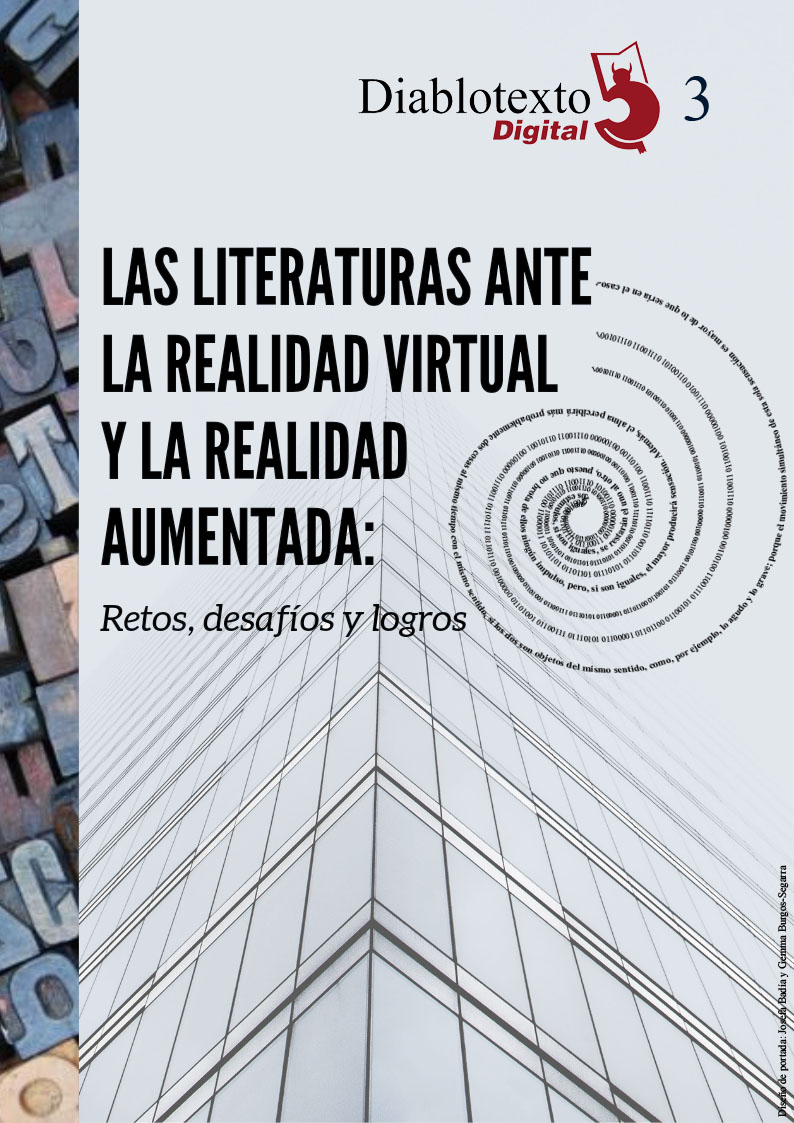Digital Narratives in the Preschool Classroom: an Experience of Research and Innovation with Booktrailer, Interactive Digital Stories and Augmented Reality
DOI:
https://doi.org/10.7203/diablotexto.3.11031Keywords:
Education, Children´s Literature, Digital Narratives, Booktrailer, Interactive Digital Story, Augmented Reality Abstract
Abstract
With the development of communication technology, children´s stories expand their aesthetic and expressive horizons. Digital narratives become a useful pedagogical tool for teachers because they catch student´s attention and fit their interests. This experience of research and innovation, developed at the University of Córdoba, focuses on the study of digital resources for reading education. We select three products that offer us many possibilities in Preschool Classroom: booktrailer, interactive digital story and Augmented Reality devices. Our work considers their many possibilities of implementation in the educational field to work essential subjects such as management of emotions, family diversity or respect for animals.
 Downloads
Downloads
 References
References
Cadeñanes Garnica, Jorge Jonathan (2014). Realidad aumentada en libros digitales educativos y juegos interactivos, tesis doctoral de la Universidad de Salamanca, en Repositorio Gredos de la Universidad de Salamanca. https://gredos.usal.es/jspui/handle/10366/125274 [Fecha de consulta: 21/11/2017].
Cassany, Daniel (2011). “Después de internet…”. Textos, 57, pp. 12-22.
Cassany, Daniel (2012). En-línea. Leer y escribir en la red. Barcelona: Anagrama.
Genette, Gérad (1987). Seuils. Paris: Éditions du Seuil.
Gray, Jonathan (2010). Show sold separately. Promos, spoilers, and other media paratexts. New York and London: New York University Press.
Ibarra-rius, Noelia; Ballester-Roca, Josep (2016). “Booktrailer en Educación Infantil y Primaria: adquisición y desarrollo de las competencias comunicativa, digital y literaria a través de narrativas digitales”, Digital Education Review, 30, pp. 76-93. https://dialnet.unirioja.es/descarga/articulo/5772443.pdf [Fecha de consulta: 21/11/2017].
Lloret Romero, Nuria; Canet Centellas, Fernando (2008). “Nuevos escenarios, nuevas formas de expresión narrativa: La Web 2.0 y el lenguaje audiovisual”. Hipertext.net. Revista Académica sobre Documentación Digital y comunicación Interactiva, 6, pp. 1-11. https://www.upf.edu/hipertextnet/numero-6/lenguaje-audiovisual.html [Fecha de consulta: 21/11/2017].
Landow, George P. (2009). Hipertexto 3.0.Teoría crítica y nuevos medios en la era de la globalización. Barcelona: Paidós.
Lluch, Gemma; Tabernero-Sala, Rosa y Calvo-Valios, Virginia (2015). “Epitextos virtuales públicos como herramientas para la difusión del libro”, El profesional de la información, 24, 6, pp. 797-804.
Mendoza Fillola (2003). “El proceso de lectura. Las estrategias”, en Pedro C. Cerrillo y Santiago Yubero (eds.), La formación de mediadores para la promoción de la lectura, pp. 183-199.
Mendoza Fillola (2007). “El proceso lector. Proceso y metacognición”. En Pedro C. Cerrillo, Cristina Cañamares y César Sánchez Ortiz (eds.), Literatura infantil: nuevas lecturas, nuevos lectores. Cuenca, Ediciones de la Universidad de Castilla-La Mancha, pp. 69-82.
Navarro, Adriana (2015). “La animación en las ilustraciones infantiles del cuento digital interactivo. Del cortometraje al libro ilustrado”. En Ilustrafic. Actas del II Congreso Internacional de Ilustración, Arte y Cultura Visual, celebrado en Valencia (1-3 octubre de 2015), pp. 263-269. DOI: http://dx.doi.org/10.4995/ILUSTRAFIC/ILUSTRAFIC2015/377
Palet i Puig, Jordi; Llorens Artiola, Ester (2005). Zapatos, zapatitos y zapatones. Badalona: Editorial Parramón.
Rovira-Collado, José (2015). “Redes sociales de lectura: del libro de caras a la LIJ 2.0”. Investigaciones Sobre Lectura ISL, 3, pp. 106-122, en http://comprensionlectora.es/revistaisl/index.php/revistaISL/issue/view/7 [Fecha de consulta: 21/11/2017].
Rovira-Collado, José (2017). Booktrailer y Booktuber como herramientas LIJ 2.0 para el desarrollo del hábito lector, Investigaciones sobre lectura, 7, 55-72.
Sampaio, Mariana; Tavares, Paula y Silva, Catarina (2012). A experiência do livro ilustrado interativo para a infância. Portugal: Confia. https://www.academia.edu/3993390/A_EXPERI%C3%8ANCIA_DO_LIVRO_ILUSTRADO_INTERATIVO_PARA_A_INF%C3%82NCIA [Fecha de consulta: 21/11/2017].
Sánchez-Claros, Juan Patricio (2016). “Nuevas alfabetizaciones en un entorno multimodal: nuevas necesidades lectoras para un entorno textual múltiple”. Investigaciones sobre Lectura, 6, pp. 51-57. http://comprensionlectora.es/revistaisl/index.php/revistaISL/article/view/153/61 [Fecha de consulta: 21/11/2017].
Tabernero-Sala, Rosa (2013). “El book trailer en la promoción del relato”. Quaderns de Filologia. Estudis literaris, 18, pp. 211-222. https://ojs.uv.es/index.php/qdfed/article/download/3302/2973 [Fecha de consulta: 21/11/2017]
Tabernero-Sala, Rosa (2015). “El book-trailer en la promoción del libro infantil y juvenil”. En Rafael Jiménez-Fernández y Manuel Francisco Romero-Oliva (eds.), Nuevas líneas de investigación e innovación en la educación literaria. Barcelona: Octaedro, pp. 99-108.
Unsworth, Len (2006). E-Literature for Children. Enhancing Digital Literacy Learning. New York: Routledge.
Downloads
Additional Files
Published
How to Cite
-
Abstract5565
-
Artículo modificado según las sugerencias de los evaluadores (Español)20
-
PDF (Español)3323
Issue
Section
License
Licencia de reconocimiento de Creative Commons “Reconocimiento - No Comercia l- Sin Obra Derivada
Authors who publish with this journal agree to the following items:
The authors will keep their copyright and guarantee the journal the right of first publication of their work, which will be simultaneously subject to the Creative Commons license that allows third parties to share the work indicating its author and its first publication in the journal. The authors may adopt other non-exclusive license agreements to distribute the version of the published work (e.g., depositing it in an institutional telematic file or publishing it in a monographic volume), with an acknowledgment of its initial publication in this journal. The authors are allowed and encouraged to disseminate their work through the Internet (e.g., in institutional telematic archives or on their website) before and during the submission process, which can produce interesting exchanges and increase citations of the published work. (See Effect of Open Access)




